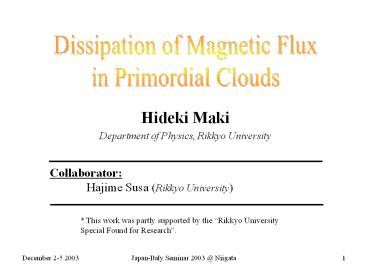Hideki Maki - PowerPoint PPT Presentation
Title: Hideki Maki
1
Dissipation of Magnetic Flux in Primordial Clouds
- Hideki Maki
- Department of Physics, Rikkyo University
Collaborator Hajime Susa (Rikkyo University)
This work was partly supported by the Rikkyo
University Special Found for Research.
2
Importance of the First Stars Mass
- Of course, itself is one of the interesting
things. - Effect for the reionization of the universe
- Massive stars ? strong UV ? earlier reionization
- Heavy elements pollution
- Massive stars ? production of heavy elements
WMAP
QSO absorption lines
The mass of first stars is important to
consider the object formation after the first
stars formed.
3
Mass of First Stars
- Star formation
- Fragments of high dense gas that are the parent
of star are formed. - Mass accretes to the core that is formed at the
center of the fragment.
envelope
stellar core
mass accretion
CDM density perturbation
fragments
(Abel et al. 2001)
4
Mass Accretion Rate
Envelope with angular momentum
Accretion disk may be formed.
- We wish a first star to be massive, then the
angular momentum must be transported effectively. - One of the possible mechanism is the turbulence
by the magnetorotational instability (MRI) in the
present-day star forming region.
(e.g. Sano, Inutsuka Miyama 1998 etc.)
But, magnetic flux has been neglected on the
studies for a first star, because one considers
that magnetic flux is very small in the early
universe.
What is the mechanism to transport the angular
momentum ?
5
Purpose
- We will study about the angular momentum
transport in the primordial case. - As first step, in order to assess the seed
magnetic flux in the accretion disk surrounding
the first stars, we investigate the appearance of
the dissipation of the magnetic flux in the
course of collapse of the primordial cloud.
6
Method Contraction
- Free-fall core collapse
- One-zone approximation
- Equation of state
- with poritoropic index ?1.1
(K constant coefficient.)
7
Method Chemical Network
Included 23 species
95 chemical reaction network
- collision ionization, collision dissociation
- recombination, electron attachment
- 3 body reaction, etc.
- no photo-ionization, no photo-dissociation
Rate equations
8
Dissipation of Magnetic Flux
Dissipation process
- Ohmic dissipation
- Magnetic energy loss as thermal energy, by
charged particles colliding with neutral
particles - Ambipolar diffusion
- Charged particles twine around the magnetic lines
by Lorenz force. On the other hand, since
neutrals are not influenced by the Lorenz force,
neutral particles fall into the stellar core with
the relative velocity for charged particles. So,
magnetic flux seems to diffuse out the cloud at
the point of neutrals.
n
n
e
n
p
e
p
e
e
p
n
p
n
n
g
B
g
B
B
p
e
p
e
p
n
n
e
n
n
9
Diffusion Velocity
In this work, the diffusion velocity of field
lines from gas is defined using the argument in
Nakano Umebayashi 1986. We investigate the
degree of dissipation by looking the diffusion
velocity compared with the free-fall velocity.
- Ohmic dissipation
- Ambipolar diffusion
electrical conductivity
viscous damping time
notation ? charged particles
notation n neutral particles
reduced mass
momentum-transfer rate coefficient
R radius of cloud, c speed of light
q charge, n number density
free-fall velocity
M mass of cloud
10
Results at Present-Day
Evolution of ionized fraction at present-day
diffusion velocity at present-day
evolution of the ionization degree
dissipation
frozen
(Nakano Umebayashi 1986)
11
Thermal Evolution of Primordial Cloud
No heavy element and grain
Collapse of the primordial cloud is proceeding at
higher temp. than present-day.
The ionization degree may be different from the
present-day case.
(Omukai 2000)
Dissipation history of the magnetic flux seems to
be different also.
12
Initial Conditions
- Density
- Temperature
- Mass Jeans mass
- Chemical abundance
- asymptotic values at low-z
- (Galli Palla
1998) - Initial magnetic flux
- Most uncertain quantity
- ? we take the initial magnetic
- flux as parameter.
13
Results Evolution Ionized Fraction
Decreases by recombination
14
Results Diffusion Velocity
Dissipation
frozen
15
MRI
- Condition in which the MRI can grow
- Growth timescale by MRI gt Dissipation timescale
(Tan Blackman 2003, astro-ph/0307455)
- If initial flux
- If initial flux
? MRI can be driven
? MRI can not be driven
16
Conclusions
- Magnetic fields are frozen, as far as the
condition that B lt Bcr 10-5(nH/103 cm-3) G is
satisfied. - If Bini gt10-11 G at nH103 cm-3, magnetic flux
might be amplified to B 10-5 G at nH 1013
cm-3. - In this case, the MRI seems to be driven
also in the primordial case.































